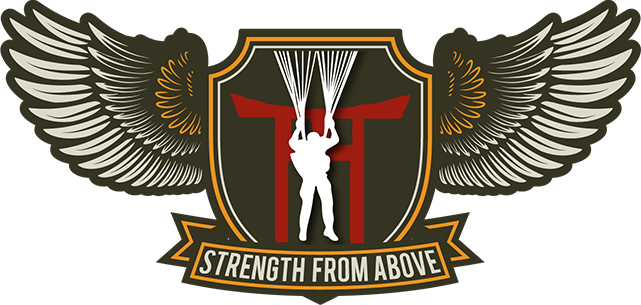"Jungle foliage was thick, making it difficult to get through," Grandpa/1LT Carrico noted of their push up and across the ridge. "We somehow kept together, fighting until about noon when Captain Cavanaugh passed another platoon through us and we were able to stop for a much-needed rest."
With rain now falling, 1st Platoon moved into the retreating enemy’s former positions. Enemy dead lay everywhere, and some were still twitching as the paratroopers kicked dirt over the corpses at the bottom of the ten to twelve foot deep troughs. The Angels breathed sighs of relief that they had survived another engagement as the success of their initial assault settled in.
"I estimated we killed over 300 that day," Grandpa/1LT Carrico later recalled.
CPL Murray Marshall Hale added, "The enemy never had a chance! How proud I am of D Company."
Listening to reports of the 1st Platoon’s effective rout on the ridge, COL Hard Rock Haugen turned to his staff and said, "Tell (General) Swing we will have the trail (to Ormoc Bay) open for him today."
 "With more bravado than sense," CPT Cavanaugh recalled, "I sent a runner to the rear to inform the Battalion Commander (Major Holcombe) that we had overcome the enemy with a bayonet charge and that he was on the run and that we were in hot pursuit." Rusty wanted to press the attack with the rest of D Company, which had now assembled, but his runner surprisingly returned with orders to halt.
"With more bravado than sense," CPT Cavanaugh recalled, "I sent a runner to the rear to inform the Battalion Commander (Major Holcombe) that we had overcome the enemy with a bayonet charge and that he was on the run and that we were in hot pursuit." Rusty wanted to press the attack with the rest of D Company, which had now assembled, but his runner surprisingly returned with orders to halt.
"Needless to say," Rusty said dryly, "I disregarded the order, feeling that if we paused the enemy would have a chance to regroup and establish defensive positions."
D Company pushed forward a short distance when another runner arrived and emphatically repeated Holcombe’s order to stop. Four hours and 2,500 yards after the attack began, Rusty reluctantly had his sweat-drenched company move off the trail to rest in a grove of palm, mango and papaya trees overlooking Ormoc Bay where they could see friendly 7th Infantry positions at the base of the mountains.
To their surprise, the next day, December 23 (D+36), a much fresher-looking 2nd Battalion of the 187th GIR, led by General Joseph Swing himself, passed D Company’s perimeter to contact the 7th ID near Albuera (and receive the accolades as the first of the 11th Airborne to reach Ormoc).
General "Jumping Joe" only paused long enough to tell CPT Cavanaugh, "Nice job," before moving on.
"My thoughts regarding that gentleman were at that (moment) anything but complimentary," Rusty recalled. With steel in their eyes, D Company watched the clean-uniformed and apparently much better fed glider-riders march past their grove towards the beach. With most of the fighting finished, the exhausted paratroopers believed the march to Ormoc Bay should have belonged to the 511th PIR.
It was rumored that COL Haugen’s men had been halted, in part, because of their haggard appearance. While they had inflicted destruction upon the enemy, the Brass felt that after their month-long ordeal in Leyte's mountains, the paratroopers looked like death themselves and wanted a fresher, clean-looking unit to arrive on the beaches for publicity photos and film reels.
This treatment was a source of resentment for the 511th PIR for years to come since General Swing later boasted that on December 22 alone "his Angels" killed 750 enemy and captured 2 mountain howitzers and 16 light and 7 heavy machine guns. Jane Carrico, 1LT Carrico’s second wife, said "the old troopers" mentioned this incident with great bitterness at every regimental and division reunion after the war.
"D Company never received the acknowledgement deserved for affecting the breakout from the mountains of Leyte," CPT Cavanaugh objected, "except for our Regimental Commander who recognized what we had done." COL Haugen let D Company know he was "damn proud" of them.
As Rusty’s exhausted and worn (but still victorious) men sat overlooking Ormoc Bay, over six-thousand miles away CPT Dick Winter’s Easy Company, 506th PIR huddled in their foxholes in Bastogne’s frozen soil.
Feeling slighted by division brass, D Company and the rest of the 511th PIR’s 2nd Battalion dug in for the night, grateful that they were within a grove of fruit trees which provided a dinner of papayas and mangos. While the stench of enemy dead made slumber difficult, CPT Cavanaugh and his men rested easier, knowing that after a month of heavy fighting they could see (and thankfully smell) the ocean just a few miles away. Let Gen. Swing and his darlings in the 187th GIR "clear" (i.e. walk safely through) the last stretch; D Company knew that "Ali Haugen’s Thieves" had paved the way with their blood, sweat, toil and tears.
Grandpa/1LT Carrico worked hard to submit the names of the charge's fighters and leaders for commendations. CPT Cavanaugh, however, wanted to make sure that Carrico wasn't overlooked. Rusty had watched Andy courageously lead 1st Platoon for over four hours in the heat of battle and wrote:
"During a four-and-a-half-hour attack against stubbornly defended enemy positions, First Lieutenant Carrico, repeatedly exposing himself to hostile fire, remained forward with the lead scouts and directed his platoon’s attack against the enemy strong points. His courageous actions inspired the men to heroic efforts, enabling them to pierce the strong defensive positions and drive the enemy from the area. The outstanding leadership displayed by First Lieutenant Carrico reflects great credit on himself and his military service."
His leadership at the front would earn 1LT Carrico his first Bronze Star.
"In my opinion it should have been a Silver Star," he observed without the least hint of guile. CPT Stephen Cavanaugh pulled my grandmother Jane aside years later at a division reunion and confirmed Andy’s assessment. The former captain actually put Grandpa in for the Silver Star and Rusty (then a retired colonel and former Chief SOG) expressed disappointment that Andy had not received the proper recognition for what he did on that ridge so many years ago.
It was a sentiment that nearly every 11th Airborne Division member I have ever spoken with expressed; not that D Company hasn't been recognized, but rather that their entire division has failed to obtain recognition similar to that gained by the 101st and 82nd Airborne Division's during the war.
To paraphrase several troopers, "They were 'over there' in Europe, we were 'over there' in the Pacific. They get books, movies and mini-series, we get forgotten and overlooked."
On Christmas Day, the battered and bloodied paratroopers of D Company, along with 2nd Battalion, began their slow march down the now-open trail to friendly lines on Ormoc Bay. Carrying their wounded with them, the 511th Parachute Infantry Regiment sang as they moved through the jungle, a touching story that I tell more fully in another article titled, "When the Angels Sang on Leyte, Christmas of 1944". I highly encourage you to read this special holiday account that brings the Christmas spirit no matter what time of the year you read it.
Thank you for taking the time to read this account of the Rat's Ass Charge. If you would like to learn more about the 11th Airborne Division in World War II, please consider purchasing a copy of our books on the Angels:


